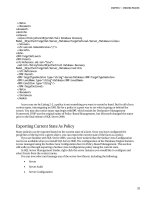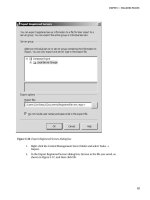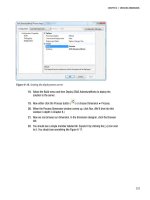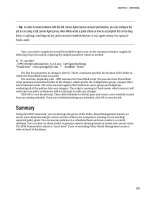Pro SQL Server 2008 Policy-Based Management- P5
Bạn đang xem bản rút gọn của tài liệu. Xem và tải ngay bản đầy đủ của tài liệu tại đây (892.89 KB, 50 trang )
CHAPTER 8 REPORTING
Tip: In order to avoid problems with the SQL Server Agent service account permissions, you can configure the
job to run using a SQL Server Agent proxy. Allen White wrote a great article on how to accomplish this on his blog
( />
Next, you need to supply the actual PowerShell script to run. In the command window, supply the
following script invocation, replacing the sample parameter values as needed:
SL “C:\scripts”
.\EPM_EnterpriseEvaluation_3.0.0.ps1 -ConfigurationGroup
"Production" -PolicyCategoryFilter "" -EvalMode "Check"
The first key parameter to change is after SL. The SL command specifies the location of the folder in
which the PowerShell script is located.
The next line, beginning with .\EPM, executes the PowerShell script. We pass the three PowerShell
script parameters described earlier in the chapter, which specify the configuration group, category filter,
and evaluation mode. The script executes against the Production server group and subgroups,
evaluating all of the policies from any category. The script is running in Check mode, which means it will
only report on policy evaluations and not attempt to make any changes.
Click OK to save the job step. Then click Schedules in the left pane and create a new schedule or pick
from an existing schedule. Once you’re finished setting up a schedule, click OK to save the job.
Summary
Using the EPM Framework, you can leverage the power of the Policy-Based Management feature set
across your enterprise and get a clear overview of how your company is meeting (or not meeting)
expected policy goals. You can execute policies on a scheduled basis and store results in a central
database. You can draw on those results to generate reports showing historical trends and current status.
The EPM Framework is almost a “must-have” if you’re extending Policy-Based Management across a
wide network of databases.
Please purchase PDF Split-Merge on www.verypdf.com to remove this watermark.
183
Please purchase PDF Split-Merge on www.verypdf.com to remove this watermark.
CHAPTER 9
Enforcing Compliance
As the demand for data keeps growing, and security and compliance keep tightening, the role of the DBA
has become an increasingly critical part of the organization. It is becoming more important for DBAs to
have a good understanding of compliance, because they are the ones responsible for securing the data.
Also, as compliance regulations continue to become more mainstream, the chances of working for a
company that does not need to comply with these regulations is becoming more and more of a rarity.
SQL Server has made several enhancements to its feature set over the years to keep up with these
growing compliance needs. As a part of these enhancements, in SQL Server 2008, you can use PolicyBased Management to ensure you have the proper server configuration and security settings in place,
along with the appropriate encryption and auditing options for your environment.
While this chapter can help you maintain a secure environment, many auditors require specific
configurations that will not be covered here. It is a good idea to document your existing procedures,
processes, and policies. Then, when auditors show up, they can audit you based on your own
documentation. Otherwise, the auditors are forced to get a best practices document from somewhere
else, and you never know what you will end up having to conform to.
Compliance Overview
Before we dig into specific examples of how to enforce compliance, let’s discuss why it is important and
how it affects your organization. First, let’s define compliance. According to mirriam-webster.com,
compliance is “conformity in fulfilling official requirements.” Other definitions of the term include
words and phrases such as “obedience” and “yield readily to others.” It’s no surprise that compliance
generally has a negative connotation associated with it. We don’t know very many people who look
forward to getting audited—whether it’s for taxes or SQL Server systems.
Compliance is the last component of the increasingly popular term GRC, which stands for
governance, risk management, and compliance. GRC is about identifying and assessing risks, developing
policies to mitigate those risks, and ensuring that those policies are in place and enforced. If any of the
components of GRC are not in place, each individual component is useless.
For example, let’s say your company deals with a lot of financial information. Financial documents
may be lying around the office. Your management has deemed it a risk to have office visitors such as
vendors wandering around the building unattended. Therefore, management has put in place a policy
that requires all office visitors to sign in, wear name tags, and always be attended by an employee. Up to
this point, you have assessed a risk and implemented a policy. However, without the proper governance
to audit the compliance with that policy, there is nothing to stop employees from letting visitors do as
they please. The same theory holds true for your servers. While you can’t always prevent users such as
system administrators from accessing certain information, you can put controls in place to audit their
activity and use Policy-Based Management to make sure those audits are being enforced.
Being the custodian of sensitive information, such as credit card numbers or personally identifiable
information (PII), is not a task that can be taken lightly. Criminals would love to get their hands on that
Please purchase PDF Split-Merge on www.verypdf.com to remove this watermark.
185
CHAPTER 9 ENFORCING COMPLIANCE
data, and in some cases, they do. According to the Privacy Rights Clearinghouse
( there have been more than 300 million
(and counting) records containing sensitive personal information involved in security breaches in the
United States since January 2005. These breaches are due to hacking, stolen computers, dishonest
employees, and so on.
A data breach not only has negative implications for the person whose data was compromised, but
can also be devastating for the organization hosting that data. The bottom line is that policies and
procedures need to be in place to protect you, the company you work for, and the sensitive information.
Compliance Regulations
In addition to having your own internal compliance standards, corporations are now expected to meet
external regulations when dealing with certain kinds of data. The following are just a few of the
regulations governing various types of organizations:
x
Gramm-Leach-Bliley Act
x
Sarbanes-Oxley Act
x
Health Insurance Portability and Accountability Act
x
Payment Card Industry Data Security Standard
The preceding list is by no means comprehensive. However, if you manage a database, chances are
at least one or more of these regulations affect you. You may notice that many of the requirements of
these regulations overlap, and a single database may fall into multiple categories.
Let’s take a quick look at these four common regulations. Then we will use the rest of the chapter to
discuss some of the ways you can use Policy-Based Management to help meet these regulations.
Gramm-Leach-Bliley Act
The Gramm-Leach-Bliley Act (GLBA) was introduced in 1999 to protect personal financial information
stored by financial institutions such as banks, insurance companies, and securities firms, along with any
other company that provides financial services or stores financial data. Compliance with GLBA is
mandatory for any company holding financial data, meaning that policies and procedures must be in
place to protect the information from malicious intent.
As organizations consolidate and combine products and services, much of your sought-after
information is housed in one place. If unregulated, companies can use this information for financial gain
by selling your data to other organizations, who might use it for marketing or sales opportunities, for
example.
In order to adhere to GLBA, companies must meet the following criteria:
x
Securely store personal financial data
x
Inform customers of the policies and procedures used for sharing their financial
data
x
Provide customers the option to opt out of sharing their financial data with
nonaffiliated companies
186
Please purchase PDF Split-Merge on www.verypdf.com to remove this watermark.
CHAPTER 9 ENFORCING COMPLIANCE
The Sarbanes-Oxley Act
The Sarbanes-Oxley Act (SOX) was enacted in 2002 due to the number of increasing corporate scandals
costing investors billions of dollars. SOX applies only to publicly traded companies. The Enron
accounting fraud scandal, which caused investors to lose nearly 11 billion dollars when the company
filed bankruptcy in 2001, was a major contributing factor to the need for the SOX. Investors need to be
assured that they are receiving accurate information on which to base their decisions about financial
investments.
While SOX was primarily intended to ensure the accuracy of financial reporting, it requires publicly
traded corporations to create and adhere to standard policies and procedures. You can use Policy-Based
Management to help ensure those policies and procedures are not violated, and that your audits go as
smoothly as possible.
SOX address issues such as the following:
x
Protection of confidential information
x
Access rights given to view confidential information
x
Logging of events on systems that store confidential information
Health Insurance Portability and Accountability Act
The Health Insurance Portability and Accountability Act (HIPAA) was enacted in 1996 and primarily
affects health-care providers handling patient information. HIPAA protects what is known as protected
health information (PHI) and electronic protected health information (EPHI), which include any health
records and payment information maintained by a health-care provider.
Prior to HIPAA, patient data was thought to be owned by the health-care provider, rather than by
the patient, as it is today. HIPAA allows patients to request their data at any given time.
HIPAA addresses issues such as the following:
x
Confidentiality of patient information
x
Disaster recovery and availability of patient information
x
Maintenance of proper audit trails on systems containing patient information
Payment Card Industry Data Security Standard
The Payment Card Industry Data Security Standard (PCI DSS) was introduced in 2004 to protect
cardholder data and applies to any organization possessing credit card information. PCI DSS is a
worldwide standard. Companies that do not comply with it can lose their ability to process credit card
data and face substantial fines. Compliance is audited regularly, but can vary based on the amount of
credit card data an organization handles.
Many new features introduced in SQL Server 2008 help you meet PCI DSS compliance. These
include transparent data encryption, Extensible Key Management, and SQL Server Audit. You can use
Policy-Based Management in conjunction with all of these new features to ensure compliance.
PCI DSS has 12 requirements, but only 6 of those requirements apply directly to SQL Server. The 12
requirements are grouped into six main objective categories, as follows (the requirements that can be
directly addressed within SQL Server are preceded with an asterisk in this list):
Please purchase PDF Split-Merge on www.verypdf.com to remove this watermark.
187
CHAPTER 9 ENFORCING COMPLIANCE
Objective 1: Build and Maintain a Secure Network
1.
Install and maintain a firewall configuration to protect cardholder data.
2.
*Do not use vendor-supplied defaults for system passwords and other security
parameters.
Objective 2: Protect Cardholder Data
3.
*Protect stored cardholder data.
4.
*Encrypt transmission of cardholder data across open, public networks.
Objective 3: Maintain a Vulnerability Management Program
5.
Use and regularly update antivirus software on all systems commonly affected
by malware.
6.
Develop and maintain secure systems and applications.
Objective 4: Implement Strong Access Control Measures
7.
*Restrict access to cardholder data by business need to know.
8.
*Assign a unique ID to each person with computer access.
9.
Restrict physical access to cardholder data.
Objective 5: Regularly Monitor and Test Networks
10. *Track and monitor all access to network resources and cardholder data.
11. Regularly test security systems and processes.
Objective 6: Maintain an Information Security Policy
12. Maintain a policy that addresses information security.
You can refer to these objectives as we discuss how to use Policy-Based Management to enforce
them throughout the rest of the chapter.
Server Configuration
One of the first lines of defense in securing your system is to make sure you have to proper server
configurations. You will need to change some configurations after you install SQL Server, such as the
number of logs SQL Server keeps before the logs are recycled and the type of logins being audited (we
will discuss the audit login configuration changes in the “Auditing” section later in this chapter). There
are other configurations you need to change in order to ensure best practice standards are in place, such
as the service account used by SQL Server as well as all of the options located under the Surface Area
Configuration facet. Let’s look at some of these configurations and see how you how you can use PolicyBased Management to make sure these configurations are enforced throughout your organization.
188
Please purchase PDF Split-Merge on www.verypdf.com to remove this watermark.
CHAPTER 9 ENFORCING COMPLIANCE
Service Account
When you install SQL Server, you are required to provide a service account for the SQL Server service.
Ideally, the service account should be a domain account with as few permissions as possible. However,
many times, you may find that the SQL Server service is running under the LocalSystem account. The
LocalSystem account has far too many privileges to be a safe account for running the SQL Server service
and is considered a security threat.
Note You should manage the SQL Server service account using the SQL Server Configuration Manager, not the
Windows Services console.
The service account that SQL Server is using is stored in the registry. The script shown in Listing 9-1
determines whether SQL Server is running as a named instance and sets the registry location
accordingly. Then it uses the xp_regread extended stored procedure to return the registry value. The
catch here is that xp_regread may itself be on the list of procedures that you should avoid in your
environment. If that is the case, you may be able to do a quick check of your existing environment, or
you may be able to evaluate the policy during certain outages or maintenance windows.
Listing 9-1. Script to return the service account used by SQL Server
DECLARE @ServiceAccount TABLE
(Value VARCHAR(50),
Data VARCHAR(50))
DECLARE @RegistryLocation VARCHAR(200)
IF CHARINDEX('\',@@SERVERNAME)=0
SET @RegistryLocation =
'SYSTEM\CurrentControlSet\Services\MSSQLSERVER'
ELSE
BEGIN
SET @RegistryLocation =
'SYSTEM\CurrentControlSet\Services\MSSQL$' +
RIGHT(@@SERVERNAME,LEN(@@SERVERNAME)CHARINDEX('\',@@SERVERNAME))
END
INSERT INTO @ServiceAccount
EXEC master.dbo.xp_regread
'HKEY_LOCAL_MACHINE' ,
@RegistryLocation,
'ObjectName'
SELECT TOP 1 Data AS ServiceAccount
FROM @ServiceAccount
Please purchase PDF Split-Merge on www.verypdf.com to remove this watermark.
189
CHAPTER 9 ENFORCING COMPLIANCE
You can use the ExecuteSql() function (introduced in Chapter 2) to create a condition that uses the
script in Listing 9-1, as follows:
1.
Create a new condition.
2.
Click the ellipsis next to the Field column to open the Advanced Edit dialog
box.
3.
Use the ExecuteSql() function to insert the script from Listing 9-1. Note that
you will need to replace all the single quotes with two single quotes before
inserting the script. Also, we will be returning a string, so that will be the first
parameter of the function. The following line of code shows a sample of the
ExecuteSql() function used in the condition:
ExecuteSql('String', 'DECLARE @ServiceAccount TABLE … ')
4.
Select != from the Operator drop-down list.
5.
Type LocalSystem in the Value column.
6.
Click OK to save the new condition.
Tip If you use a standard service account for SQL Server, it would be even more secure to set the remaining
expression to = 'DomainName\ServiceAccount', instead of != 'LocalSystem'.
You can now create a new policy that uses this condition, and will fail if SQL Server is running under
the LocalSystem account.. Use the Server facet to create the policy, since the service account applies to
the entire SQL Server instance. Figure 9-1 shows an example of the evaluation results for a SQL Server
instance that is using the LocalSystem account.
190
Please purchase PDF Split-Merge on www.verypdf.com to remove this watermark.
CHAPTER 9 ENFORCING COMPLIANCE
Figure 9-1. Evaluation results for a SQL Server instance that is using the LocalSystem account
Log Retention
Each time SQL Server is restarted, the old log file is renamed, and a new log file is created. By
default, SQL Server keeps only six error logs. If you are having issues with your server and reboot the
machine or recycle the SQL Server Service a few times, those six logs can become useless really fast. Most
auditors will want you to increase the log retention to the maximum setting, which is 99.
Note: We have even heard of a case where an auditor suggested editing the registry to increase the number of
logs beyond 99. While editing the registry to increase the number of error logs may work, anything above 99 is an
unsupported setting that we do not recommend.
To configure the log retention for SQL Server, expand the Management node in Object Explorer,
right-click the SQL Server Logs folder, and select Configure from the context menu. In the Configure SQL
Server Error Logs dialog box, check the Limit the Number of Error Log Files before They Are Recycled
check box to enable the Maximum Number of Error Log Files text box and enter 99, as shown in Figure
Please purchase PDF Split-Merge on www.verypdf.com to remove this watermark.
191
CHAPTER 9 ENFORCING COMPLIANCE
9-2. Click OK to apply the changes. If the check box is unchecked, and no value is specified, SQL Server
will keep six error log files.
Figure 9-2. Configure SQL Server Error Logs dialog box
You can use the script in Listing 9-2 to return the number of error logs retained by SQL Server. First,
the script checks the registry to find the value for the instance name you are using. The value that
correlates to the instance name will be something like MSSQL.1 or MSSQL.2 for SQL Server 2005 and
MSSQL10.InstanceName for SQL Server 2008. You need this value to reference the complete registry path
used in the second part of the script to retrieve the number of error logs.
Listing 9-2. Script to return the number of error logs retained by SQL Server
DECLARE
DECLARE
DECLARE
DECLARE
@RegValues TABLE(Value VARCHAR(50), Data VARCHAR(50))
@RegPath VARCHAR(200)
@ObjectName VARCHAR(50)
@RegLocation VARCHAR(50)
192
Please purchase PDF Split-Merge on www.verypdf.com to remove this watermark.
CHAPTER 9 ENFORCING COMPLIANCE
--1. Get the location of the instance name in the registry
SET @RegPath = 'Software\Microsoft\Microsoft SQL Server\Instance Names\SQL\'
IF CHARINDEX('\',@@SERVERNAME) = 0
--Not a named instance
SET @ObjectName = 'MSSQLSERVER'
ELSE
--Named instance
SET @ObjectName = RIGHT(@@SERVERNAME,LEN(@@SERVERNAME) - CHARINDEX('\',@@SERVERNAME))
INSERT INTO @RegValues
EXEC master.dbo.xp_regread
'HKEY_LOCAL_MACHINE',
@RegPath,
@ObjectName
SELECT @RegLocation = Data
FROM @RegValues
--2. Now get the number of error logs based on the location
SET @RegPath = 'Software\Microsoft\Microsoft SQL Server\' +
@RegLocation + '\MSSQLServer'
SET @ObjectName = 'NumErrorLogs'
DELETE FROM @RegValues
INSERT INTO @RegValues
EXEC master.dbo.xp_regread
'HKEY_LOCAL_MACHINE',
@RegPath,
@ObjectName
SELECT Data
FROM @RegValues
Tip: You should cycle your error logs on a regular basis (generally daily or weekly) using the
sp_cycle_errorlog system stored procedure to keep the log files a manageable size. Executing the
sp_cycle_errorlog command closes the current error log and creates a new one, just as a SQL Server restart
does. Controlling the size of your error logs is especially important if you increase the number of error logs
retained by SQL Server.
You can use the script in Listing 9-2 to create a condition using the ExecuteSql() function, in the
same way as described for the script in Listing 9-1 for checking the service account. For this condition,
the remaining expression after the ExecuteSql() function should read = 99.
Please purchase PDF Split-Merge on www.verypdf.com to remove this watermark.
193
CHAPTER 9 ENFORCING COMPLIANCE
Surface Area Configuration
By default, many features are disabled when you finish installing SQL Server, and you can use the
Surface Area Configuration facet to make sure they stay that way. You should enable only the features
needed by your application to reduce security threats. You can import four predefined Surface Area
Configuration policies to help you secure your environment:
x
Surface Area Configuration for Database Engine 2005 and 2000 Features
x
Surface Area Configuration for Database Engine 2008 Features
x
Surface Area Configuration for Service Broker Endpoints
x
Surface Area Configuration for SOAP Endpoints
The following settings are controlled by the Surface Area Configuration for Database Engine 2008
Features policy (the default for all of these is False, so none of them are enabled by default):
x
AdHocRemoteQueriesEnabled
x
ClrIntegrationEnabled
x
DatabaseMailEnabled
x
OleAutomationEnabled
x
RemoteDacEnabled
x
ServiceBrokerEndpointActive
x
SoapEndpointsEnabled
x
SQLMailEnabled
x
XPCmdShellEnabled
The settings controlled by the Surface Area Configuration for Database Engine 2005 and 2000
Features policy are the same, with the addition of WebAssistantEnabled, which was deprecated in SQL
Server 2005. Each policy has a server restriction that prevents the policy from running against
inappropriate versions of SQL Server.
You can change these values using the sp_comfigure system stored procedure or check their current
values using the sys.configurations catalog view. For example, the script in Listing 9-3 will enable
xp_cmdshell on your server.
Listing 9-3. Script to enable xp_cmdshell
EXEC sp_configure 'show advanced options', 1
GO
RECONFIGURE
GO
-- Enable xp_cmdshell
EXEC sp_configure 'xp_cmdshell', 1
GO
RECONFIGURE
GO
194
Please purchase PDF Split-Merge on www.verypdf.com to remove this watermark.
CHAPTER 9 ENFORCING COMPLIANCE
Since xp_cmdshell is considered an advanced option, you must first change the show advanced
options setting to true using sp_configure before you can enable it. If someone enables a feature such as
xp_cmdshell, which allows you to run external operating system commands, you can capture the event
and raise an alert using the methods discussed in Chapter 5. Figure 9-3 shows the Windows event log
with an alert that was raised due to enabling xp_cmdshell using the script in Listing 9-3.
Figure 9-3. Error raised by enabling xp_cmdshell
Security
Tightening access to your servers by managing the appropriate security permissions is another
important part of maintaining compliance. As a DBA, it is your job to make sure people can access only
the objects they are supposed to access. You should always provide the minimum level of permissions
users need in order to perform their tasks.
Figure 9-4 provides a good visual representation of the security features in SQL Server and how they
relate to each other. You may find it helpful to refer back to Figure 9-4 throughout the remainder of this
chapter.
Please purchase PDF Split-Merge on www.verypdf.com to remove this watermark.
195
CHAPTER 9 ENFORCING COMPLIANCE
Figure 9-4. SQL Server 2008 security features
You can classify security objects as either principals or securables. A principal is an object that can
request access to SQL Server. A securable is an object in SQL Server that you can protect by setting and
managing permissions. In simple terms, principals try to access securables, but principals can access
those securables only if you have granted them the appropriate permission to do so. You can implement
a few policies to help you reduce security threats to those securables by limiting the use of
administrative accounts. There are also several predefined security policies provided with the
installation that you can import.
Administrative Accounts
You should be extremely mindful of who has administrative access to your SQL Server systems. While
you must be cautious of all administrative accounts in your environment, two particular accounts pose
more of a threat than the others do. Both Builtin\Administrators and sa (system administrator) are
considered a security threat, and you should take extra measures to protect access using these accounts.
196
Please purchase PDF Split-Merge on www.verypdf.com to remove this watermark.
CHAPTER 9 ENFORCING COMPLIANCE
Removing the Builtin\Administrators Login
Prior to SQL Server 2008, by default, anyone who has administrative access to the server also has
administrative access to SQL Server. This administrative access is given through a SQL Server login
called Builtin\Administrators, which is mapped to the Windows Administrators group. The
Builtin\Administrators login is not present in SQL Server 2008 unless someone specifically adds it.
If you are using SQL Server 2005, it is considered a best practice security measure to remove the
Builtin\Administrators login. You can remove the login by running the following command:
DROP LOGIN [Builtin\Administrators]
Caution Before removing any administrative accounts in SQL Server, make sure you have alternative
administrative access with other logins.
In order to make sure that you don’t have any servers using the Builtin\Administrators login or to
ensure that no one adds the login back once you remove it, you can create a policy that checks the
sys.serverprincipals catalog view for the login name by using the query in Listing 9-4.
Listing 9-4. Query to check for the Builtin/Administrators login
SELECT COUNT(*)
FROM sys.server_principals
WHERE name = 'Builtin\Administrators'
Now that you have the query that checks for the existence of the login, it is easy to create a condition
using the ExecuteSql() function, just as we did for the service account earlier in the chapter. Since we
don’t want any occurrences of the Builtin\Administrators account, for this condition the remaining
expression after the ExecuteSql() function should read = 0.
Disabling the sa Login
It is considered bad practice to log in using the sa account, because the sa login has the highest
permission set within SQL Server and also provides anonymity to the user who actually logs in. If you
install SQL Server allowing only Windows authentication, the sa account is disabled; otherwise, it is
enabled.
If you are using mixed-mode authentication, it is considered a best practice security measure to
disable the sa login. You can disable the sa login by running the following command.
ALTER LOGIN sa DISABLE
Please purchase PDF Split-Merge on www.verypdf.com to remove this watermark.
197
CHAPTER 9 ENFORCING COMPLIANCE
Caution Before disabling the sa login, you should verify that it is not being used by your application
connections or SQL Agent jobs.
You can create a policy that checks the sys.serverprincipals catalog view to make sure the sa login
is disabled by using the query in Listing 9-5.
Listing 9-5. Query to make sure the sa login is disabled
SELECT COUNT(*)
FROM sys.server_principals
WHERE name = 'sa' AND
disabled = 1
Again, after you have the query, you can create a condition using the ExecuteSql() function. And
since we don’t want any occurrences of an enabled sa account, for this condition, the remaining
expression after the ExecuteSql() function should read = 0.
Best Practice Security Policies
Along with creating custom policies to secure you servers, you can import Microsoft best practice
security policies to help protect your server. As explained in Chapter 2, when you import these policies,
they will be in their own category called Microsoft Best Practices: Security.
The following are the best practice security policies provided by Microsoft, excluding the best
practice policies related to encryption, which are listed later in the chapter:
CmdExec Rights Secured: This policy uses an underlying condition called CmdExec
Rights for sysadmins Only and uses a server restriction called SQL Server Version
2000. It ensures that only sysadmins can run CmdExec and ActiveX script job steps
in SQL Server 2000.
Guest Permissions: This policy uses an underlying condition called Has No
Database Access that applies to all user databases, along with the model system
database, and has no server restrictions. It is best practice to revoke access from
the guest account in all databases except master and tempdb, if your applications
are not using this account. You can disable the guest account on a database by
running the command REVOKE CONNECT FROM GUEST.
Public Not Granted Server Permissions: This policy uses an underlying condition
called Public Server Role Has No Granted Permissions and has no server
restrictions. It ensures that server permission is not granted to the public role.
Since every login you create has access to the public server role, if the public role
has server permissions, every login will have server permissions as well.
SQL Server Login Mode: This policy uses an underlying condition called Windows
Authentication Mode that checks to make sure the login mode is Windows
integrated authentication and has no server restrictions. It is considered best
practice to use Windows integrated authentication instead of mixed-mode
198
Please purchase PDF Split-Merge on www.verypdf.com to remove this watermark.
CHAPTER 9 ENFORCING COMPLIANCE
authentication whenever possible. However, in real-world practice, using Windows
integrated authentication only is rarely an option.
SQL Server Password Expiration: This policy uses an underlying condition called
Password Expiration Enabled and uses a server restriction called SQL Server 2005
or a Later Version. This policy ensures that password expiration is enabled on all
SQL Server logins. It is valid only on SQL Server 2005 or later, since password
expiration is not an option in SQL Server 2000. The password expiration option is
dependent on the enforce password policy option being enabled as well.
SQL Server Password Policy: This policy uses an underlying condition called
Password Policy Enforced and uses a server restriction called SQL Server 2005 or a
Later Version. This policy ensures that the password policy is enforced on all SQL
Server logins. It is valid only on SQL Server 2005 or later, since enabling the
password policy is not an option in SQL Server 2000. This policy uses the
NetValidatePasswordPolicy API, which is available in Windows 2003 or later, to
enforce password complexity.
Trustworthy Database: This policy uses an underlying condition called Database
Owner Not sysadmin and uses a server restriction called SQL Server 2005 or a Later
Version. This policy ensures that no login in the db_owner role has sysadmin
privileges on databases where the Trustworthy property is enabled.
Encryption
Microsoft has made some key additions to encryption by introducing the new transparent data
encryption and Extensible Key Management technologies. These new features are an integral part of
meeting the growing compliance needs of the organization. Along with being able to use Policy-Based
Management to help with these new features, some predefined policies can assist you with the features
introduced in SQL Server 2005. If you will be using encryption in your environment, we highly
recommend the book Expert SQL Server 2008 Encryption by Michael Coles and Rodney Landrum
(Apress, 2009).
Transparent Data Encryption
Transparent data encryption enables the DBA to store the data, log, and backup files in a secure manner
by automatically encrypting and decrypting the data as it is read from and written to the disk. The
database uses a database encryption key, and without the correct certificate, the data files or the
backups cannot be restored to another server. This process is implemented at the data layer and is
transparent to front-end applications. This does not mean that the data is encrypted between the
application and the server; only the pages containing the data on the server are encrypted.
You can create a policy for your databases that requires transparent data encryption, using the
EncryptionEnabled property of the Database facet to ensure that it is enabled. As discussed in Chapter 2,
you can create a policy by exporting the current state of an object. For example, you can right-click a
database and select Facets from the context menu to display the View Facets dialog box. The example in
Figure 9-5 shows this dialog box with the EncryptionEnabled property set to True for the
AdventureWorks2008 database.
Please purchase PDF Split-Merge on www.verypdf.com to remove this watermark.
199
CHAPTER 9 ENFORCING COMPLIANCE
Figure 9-5. View Facets dialog box showing the Database facet with EncryptionEnabled set to True
In order to create a policy, you could click the Export Current State as Policy button, or you could
just create a new policy using the EncryptionEnabled property.
Note: Keep in mind that if you export the current state of the database, you will create a policy that ensures all
the database options remain the same, not just the property you enabled, such as EncryptionEnabled or
ExtensibleKeyManagementEnabled.
200
Please purchase PDF Split-Merge on www.verypdf.com to remove this watermark.
CHAPTER 9 ENFORCING COMPLIANCE
Extensible Key Management
Extensible Key Management provides an enhanced method for managing encryption keys. It enables
third-party software vendors to provide and manage keys by supporting hardware security module
(HSM) products that can be registered and used with SQL Server. This provides many advantages,
including the physical separation of data and keys. If you are using Extensible Key Management, you can
ensure that it is enabled by using the ExtensibleKeyManagementEnabled property in the Server
Configuration facet.
You can view the Server Configuration facet and all the properties it exposes by right-clicking the
SQL Server instance and selecting Facets from the context menu. Once the View Facets dialog box is
displayed, change the Facet option from Server to Server Configuration. You can see the
ExtensibleKeyManagementEnabled property is set to True for the instance in the example in Figure 9-6.
Figure 9-6. View Facets dialog box showing the Server Configuration facet with the
ExtensibleKeyManagementEnabled property set to True
Please purchase PDF Split-Merge on www.verypdf.com to remove this watermark.
201
CHAPTER 9 ENFORCING COMPLIANCE
In order to create a policy, you could either click Export Current State as Policy or just create a new
policy using the ExtensibleKeyManagementEnabled property.
Best Practice Encryption Policies
In addition to the best practice security policies listed in the “Best Practice Security Policies” section
earlier in this chapter, you can import the following Microsoft best practice encryption policies:
Asymmetric Key Encryption Algorithm: This policy uses an underlying condition
called RSA 1024 or RSA 2048 Encrypted and a server restriction called SQL Server
2005 or a Later Version. It ensures that every asymmetric key in every database has
at least 1024-bit encryption.
Symmetric Key Encryption for User Databases: This policy uses an underlying
condition called Strongly Encrypted and a server restriction called SQL Server 2005
or a Later Version. It checks to make sure every symmetric key that is less than 128
bytes in every database does not use the RC2 or RC4 encryption algorithm. If it is
supported by your operating system, you should use AES 128-bit and above
encryption; otherwise, you should use 3DES to create your symmetric keys.
Symmetric Key for master Database: This policy uses an underlying condition called
Microsoft Service Master Key and a server restriction called SQL Server 2005 or a
Later Version. It verifies that the symmetric key in the master database is the
service master key and not a user-defined symmetric key.
Symmetric Key for System Databases: This policy uses an underlying condition
called Fail For Any Symmetric Key and has a server restriction called SQL Server
2005 or a Later Version. It checks every system database except master to ensure
there are no symmetric keys.
Auditing
Auditing your servers is a key part in maintaining compliance within your organization. An audit should
provide the answers to the following questions:
x
Who did something
x
What they did
x
How they did it
x
When they did it
You must retain your audit logs for one year in order to meet PCI DSS compliance. You should
review you audit criteria and choose exactly what needs to be audited, so that you do not end up with an
overwhelming amount of information. In addition, audit trails must be tamperproof, meaning that the
audit logs should be stored in a directory that is not accessible to the DBA. Once you have defined your
audit criteria, you can use Policy-Based Management to help you enforce it.
202
Please purchase PDF Split-Merge on www.verypdf.com to remove this watermark.









